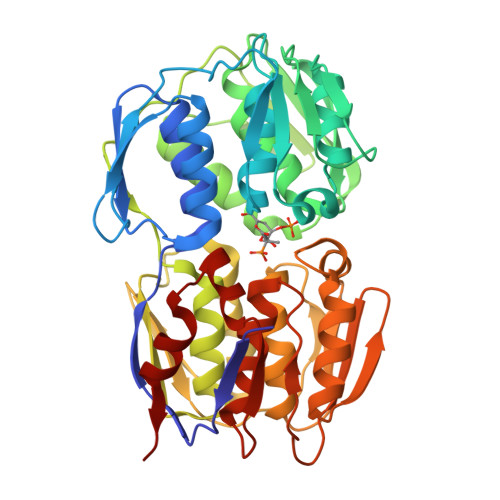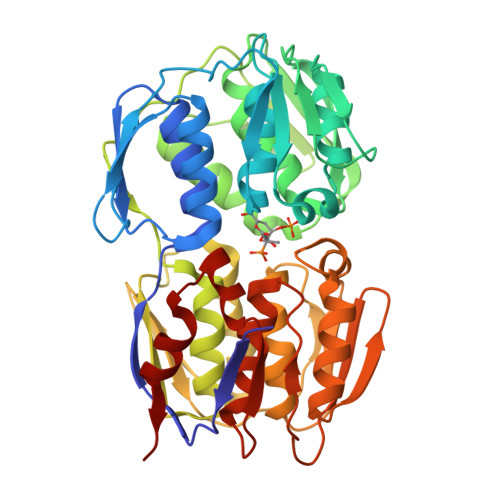Interaction of phosphonate analogues of the tetrahedral reaction intermediate with 5-enolpyruvylshikimate-3-phosphate synthase in atomic detail.
Priestman, M.A., Healy, M.L., Becker, A., Alberg, D.G., Bartlett, P.A., Lushington, G.H., Schonbrunn, E.(2005) Biochemistry 44: 3241-3248
- PubMed: 15736934
- DOI: https://doi.org/10.1021/bi048198d
- Primary Citation of Related Structures:
1X8R, 1X8T - PubMed Abstract:
The enzyme 5-enolpyruvylshikimate-3-phosphate synthase (EPSPS) catalyzes the penultimate step of the shikimate pathway and is the target of the broad-spectrum herbicide glyphosate. Since the functionality of the shikimate pathway is vital not only for plants but also for microorganisms, EPSPS is considered a prospective target for the development of novel antibiotics. We have kinetically analyzed and determined the crystal structures of Escherichia coli EPSPS inhibited by (R)- and (S)-configured phosphonate analogues of the tetrahedral reaction intermediate. Both diastereomers are competitive inhibitors with respect to the substrates of the EPSPS reaction, shikimate-3-phosphate (S3P) and phosphoenolpyruvate (PEP). Remarkably, the (S)-phosphonate (K(iS3P) = 750 nM), whose configuration corresponds to that of the genuine tetrahedral intermediate, is a much weaker inhibitor than the (R)-phosphonate analogue (K(iS3P) = 16 nM). The crystal structures of EPSPS liganded with the (S)- and (R)-phosphonates, at 1.5 and 1.9 A resolution, respectively, revealed that binding of the (R)-phosphonate induces conformational changes of the strictly conserved residues Arg124 and Glu341 within the active site. This appears to give rise to substantial structural alterations in the amino-terminal globular domain of the enzyme. By contrast, binding of the (S)-phosphonate renders the enzyme structure unchanged. Thus, EPSPS may facilitate the tight binding of structurally diverse ligands through conformational flexibility. Molecular docking calculations did not explain why the (R)-phosphonate is the better inhibitor. Therefore, we propose that the structural events during the open-closed transition of EPSPS are altered as a result of inhibitor action.
Organizational Affiliation:
Department of Medicinal Chemistry, University of Kansas, Lawrence, Kansas 66045, USA.


















